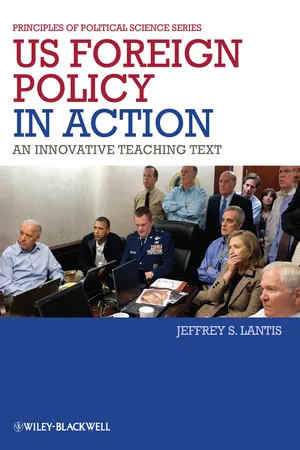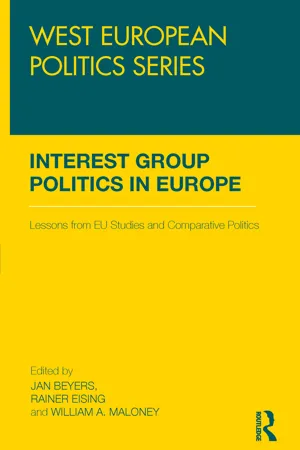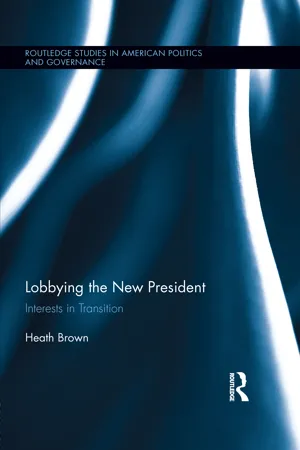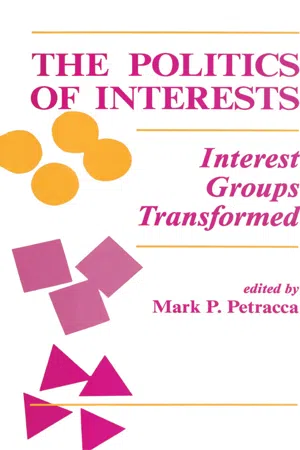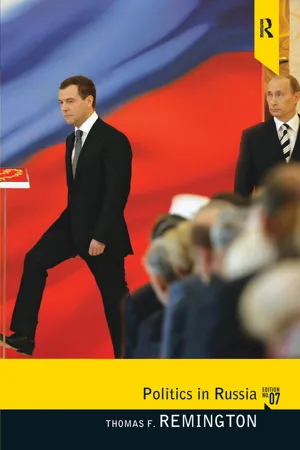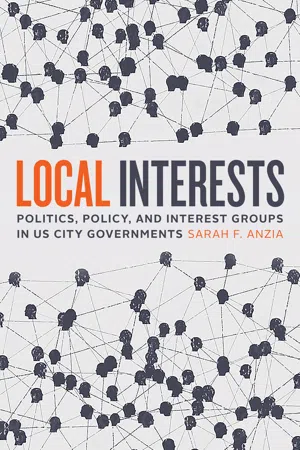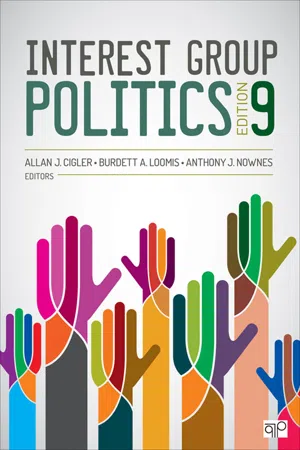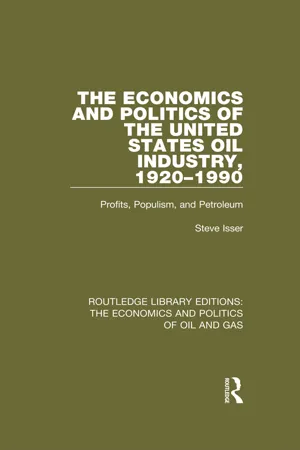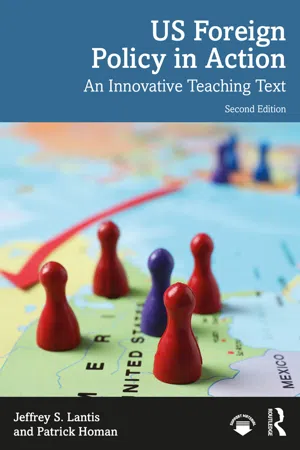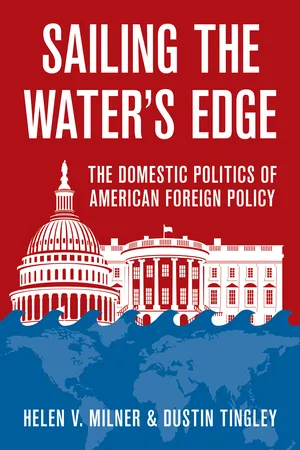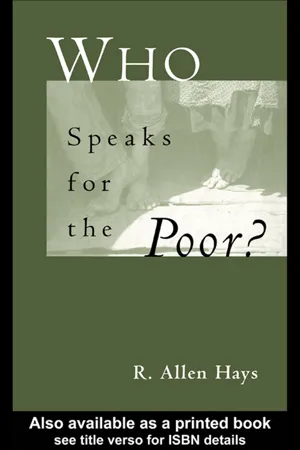Politics & International Relations
Interest Groups
Interest groups are organizations that seek to influence public policy and government decisions on behalf of their members. They often focus on specific issues or industries and use various tactics such as lobbying, public relations, and campaign contributions to advance their interests. Interest groups play a significant role in shaping political agendas and policies.
Written by Perlego with AI-assistance
Related key terms
12 Key excerpts on "Interest Groups"
- eBook - ePub
US Foreign Policy in Action
An Innovative Teaching Text
- Jeffrey S. Lantis(Author)
- 2012(Publication Date)
- Wiley-Blackwell(Publisher)
Interest Groups, or lobbies, are organizations that seek to influence government policy outcomes to their own, cartelized special concerns. Interest Groups may represent a wide range of constituencies, from farmers and families to immigrant groups and corporations, while actual lobbies are specialized in their representation of interests. For example, lobbies may represent for-profit companies, like military contractors or automobile manufacturers, or non-profit concerns like protection of human rights or the environment. The most effective foreign policy Interest Groups are typically well organized, managed by a national organization with staff and resources, and have a broad membership. However, scholars disagree whether interest group engagement in the policy process is constructive. Some champion democratic ideals and the “power of the people” to shape political decisions; others argue that Interest Groups have far less to do with traditional democratic principles versus organized, narrowly defined interests. To critics, foreign policy is much too heavily influenced by Interest Groups, while average citizens are left out of the political process.Historical Controversy
The involvement of Interest Groups in policy-making has been controversial for more than 200 years. Framers who debated different models of governing arrangements were mindful of concerns about such groups. James Madison argued in Federalist Paper No. 10 that one of the best reasons to establish a federal government was that it would help manage potentially dangerous effects of “factions.” He argued: “Among the numerous advantages promised by a well-constructed Union, none deserve to be more accurately developed than its tendency to break and control the violence of faction.”3 He also recognized an inherent tension between the rights of such groups to represent their interests and a broader measure of civic freedom. Yet others maintain representation in any form is guaranteed by the Constitution and Bill of Rights. Ensuring the legitimacy of group activities was essential to curtail the power of the federal government and promote democracy.4 - eBook - ePub
Interest Group Politics in Europe
Lessons from EU Studies and Comparative Politics
- Jan Beyers, Rainer Eising, William A. Maloney(Authors)
- 2013(Publication Date)
- Routledge(Publisher)
The practice of lobbying can create positive externalities that are not directly related to policy outcomes. The political activities of many Interest Groups are not limited to lobbying on specific issues, but include diffuse practices such as attending workshops, receptions, press conferences, monitoring newspaper and other media stories. Interest Groups monitor the policy process to generate information for their clients and constituencies. Interest group goals are often quite diffuse. Many interest group activities concern what we could call ‘market policies’, that try to shape the reputation of groups and the sector they represent among a broader set of market participants including consumers, stakeholders and competitors. Image building, reputation management and/or damage control are relevant aims for many Interest Groups. Finally, as noted above, in some areas it makes little sense to speak about Interest Groups influencing policies or pressurising policy-makers because they are integral to the design and execution of public policies (e.g. standard-setting or private rule-making). In these areas, the distinct roles traditionally attributed to public and private actors are blurring (Lehmbruch 1977; Cowles 2003). The EU system of interest representation is also a rich laboratory for the study of interest group politics from a broader perspective – i.e. how groups act, develop and survive in a system that is neither a traditional state nor a traditional international organisation. One of the intriguing puzzles is that the expanding scope of the EU seems to increase the diversity of the interests mobilised. While the initial focus on market integration certainly provided greater incentives for economic – export-oriented – interests to get organised and represent their interests at EU level, the EU is now expanding its scope of governance into other policy areas such as social, immigration, and foreign policy - eBook - ePub
- Heath Brown(Author)
- 2013(Publication Date)
- Routledge(Publisher)
This is not an uncontroversial categorization, as some scholars have sought to group non-traditional groups as Interest Groups. For instance, NGOs with no formal members can conceivably act on behalf of their constituents, the beneficiaries of health services or cultural activities, even if the constituents are not dues-paying members (Berry & Arons, 2003). The same could be said of businesses that seek to influence politics on behalf of customers who have no say in the operations of the business. Recognizing those caveats, the focus of this work and most interest group research is on the aggregation of individuals, be they individual citizens, individual corporations, or individual NGOs. When each joins forces around a common political or policy interest, then we can classify the resulting association or collective as a special or organized interest group.Also not included in this analysis are membership groups that serve non-political ambitions. Browne (1990) distinguished a group such as the Rotary Club from the NRA. Both are organizations that have members who share interests, but the interests that Rotarians share are not fundamentally political or policy-oriented. As a result, in fulfilling their mission, Rotary Clubs do not seek out political power or influence over the policy process. While they must overcome the collective action problems of membership, they cannot be labeled as political Interest Groups, and therefore this category of organized group is excluded from the analysis to come.TAX STATUS AND LOBBYING
The US government has sought to use the tax code to distinguish between non-profits that pursue social missions from other groups formed to pursue particular political interests. Interest Groups are typically organized as nonprofit organizations and claim legal and tax benefits from this status (Berry, 1999; Berry & Arons, 2003; Wyszomiriski, 1998). As non-profits, they may not generate and distribute profits for shareholders and must be primarily established to serve a social function. Some non-profit Interest Groups are legally classified as 501c(3) and others as 501c(4), 501(c)5, and 501(c)6.5 - eBook - ePub
The Politics Of Interests
Interest Groups Transformed
- Mark P Petracca(Author)
- 2018(Publication Date)
- Routledge(Publisher)
An interest group is a specific organization like the Missouri Bus and Truck Association, which is an association of bus and trucking companies, but the members of this organization are also part of the broader interest category of transportation. This includes, for example, air carriers, railroads, and petroleum suppliers. Bus and truck operators are also part of the even broader category of the Missouri business lobby, which includes all those groups and organizations—such as manufacturing companies, bankers, retailers, liquor dealers, and a host of others—interested in promoting conditions favorable to business operations. Although it is often difficult to draw hard and fast lines between the terms interest group, interest, and lobby, the distinction is useful for understanding the various aspects of group activity presented here. 5. The major works on state Interest Groups are Zeller 1954.190-191 and ch. 13, "Pressure Group Influence and Their Control"; Morehouse 1981, especially ch. 3, "Pressure Groups Versus Political Parties"; Zeigler 1983; Zeigler and van Dalen 1976; and Zeigler and Baer 1969. Related academic works are John C. Wahlke, Heinz Eulau, William Buchanan, and Leroy C. Ferguson, The Legislative System (New York: John Wiley and Sons, 1962); and Wayne L. Francis, Legislative Issues in the Fifty States: A Comparative Analysis (Chicago: Rand McNally, 1967). Historical perspectives on Interest Groups in the states can be supplemented by popular works such as John Gunther, Inside U.S.A. (New York: Harper and Brothers, 1951); and the series of books by Neal R. Peirce on the various subregions of the United States, plus Neal R. Peirce and Jerry Hagstrom, The Book of America: Inside Fifty States Today (New York: W. W. Norton, 1983) - eBook - ePub
- Thomas Remington(Author)
- 2015(Publication Date)
- Routledge(Publisher)
No longer did the state demand that organized groups serve a single, state-defined political agenda, as was the case under the old regime. Now, groups could form freely to represent a diversity of interests, compete for access to influence and resources, and define their own agenda. Today, it is estimated that there are about a quarter of a million nongovernmental organizations (NGOs) in existence. 10 Political scientists have observed that Interest Groups generally pursue either “inside” or “outside” strategies for influencing policy. That is, either they tend to concentrate their resources on cultivating close, friendly relations with key policymakers or they seek to build large public followings and membership bases that can apply pressure on policymakers through elections, demonstrations, letter-writing campaigns, and media attention. 11 The effectiveness of insider strategies depends on establishing relations of trust, which generally requires that the group’s representatives and the policymakers keep each others’ confidences. That can make it difficult to judge how powerful an “insider” group is. In the case of Russian groups, we see various combinations of strategies. Some older organizations that survived into the new era cling to their organizational assets and legacies and take advantage of their “insider” access to the state. Some that have sprung up from scratch also work closely with legislative and executive authorities, but others play “outsider” roles, trying to influence government by mobilizing public attention and support. Still others try to use both. The rapid changes in the structure of social relations have meant that both old and new organizations have had a difficult time keeping a firm base of support. Some organizations that appeared influential at first have turned out to be little more than an empty shell. Other Interest Groups have proven to be very strong politically even though they are not formally organized - eBook - ePub
Local Interests
Politics, Policy, and Interest Groups in US City Governments
- Sarah F. Anzia(Author)
- 2022(Publication Date)
- University of Chicago Press(Publisher)
Chapter TwoThe Policy-Focused Approach to Studying Interest Groups
If we allow ourselves to step back and ask why it is important to study Interest Groups, the answer comes easily: because Interest Groups might influence politics and policy. We know that political and policy outcomes don’t always align with citizens’ preferences.1 Some major policy enactments are wildly unpopular, and some proposals that are popular don’t get enacted. There are also important policy and political economic shifts that cannot be explained by shifts in public opinion.2 Interest Groups are important to study because they might contribute to these phenomena. They are important to understand because they might have influence.Whether stated explicitly or not, research on political representation is also about influence. It is just that it has mainly focused on the influence of mass publics, conceiving of the potential “influencers” as individual citizens and their preferences. But while Interest Groups have played a secondary role in such models—if they are considered at all—there are strong reasons to think that Interest Groups have even greater potential for influence than individuals operating autonomously. The sole political activity of most individuals is voting. By itself, casting a vote for a candidate does not clearly communicate policy preferences. How, then, do policy makers know what their constituencies want, so that they can be responsive to them should they wish? Often they learn from other political activities that more effectively convey policy preferences, such as communicating with officials, testifying at hearings, and lobbying. Crucially, moreover, those activities are often executed and coordinated by organized groups. Then there is the question of how individuals come to have certain policy preferences in the first place, how they know which policy proposals are in their interests, and how they become mobilized into political action on the basis of those preferences. Typically individuals don’t do all of this on their own, in isolation. Groups are critical in this regard.3 - eBook - ePub
- Allan J. Cigler, Burdett A. Loomis, Anthony Nownes(Authors)
- 2015(Publication Date)
- CQ Press(Publisher)
- The growth of activity and impact of institutions, including corporations, universities, state and local governments, and foreign interests
- A continuing rise in the amount and sophistication of group activity in state capitals, especially given the devolution of some federal programs and substantial increases in state budgets
All these developments have antecedents in earlier eras of American political life; there is little that is genuinely new under the interest group sun. Political action committees have replaced (or complemented) other forms of special interest campaign financing. Group-generated mail directed at Congress has been a tactic since at least the early 1900s.1 Many organizations have long been centered in Washington, DC, members of Congress traditionally have represented local interests, and so on.Still, the level of group activity, coupled with growing numbers of organized interests, distinguishes contemporary group politics from the politics of earlier eras. Group involvement trends lend credence to the fears of scholars such as political scientist Theodore Lowi and economist Mancur Olson, who have viewed interest-based politics as contributing to governmental stalemate and reduced accountability.2 - eBook - ePub
The Economics and Politics of the United States Oil Industry, 1920-1990
Profits, Populism and Petroleum
- Steve Isser(Author)
- 2016(Publication Date)
- Routledge(Publisher)
VII Interest Groups, Rent Seeking, and Oil Politics Explanations of economic regulation have ranged from a naive belief that government endeavored to further the public interest to an overly mechanical and cynical belief that self-interested behavior controls politics and policy development. The evolution of the theory of economic politics has been convoluted, involving a number of strands of thinking in two interlinked disciplines. In political science, interest group theory and pluralism can be traced back to the Federalist. The emergence of Public Choice theory with the application of microeconomic theory to the analysis of politics raised questions about the assumptions underlying traditional interest group theories. Parallel with this development, economists began to model political behavior as merely another form of economic behavior, challenging the traditional view of economic regulation as motivated by a desire to further the public interest. Finally, a backlash against the simplistic formulas of economic politics has emerged, creating a far richer and more complex picture of political behavior, but one which is analytically far more intractable, providing new legitimacy for the economic and political historian. I place myself firmly in this last camp, contending that social phenomena are too complex to be fully explained by simple models of rational self-interested behavior. Interest Group Theory Concern with the power of Interest Groups, especially economic Interest Groups, to determine government policy can be traced back to essay number 10 of the Federalist, written by James Madison. Madison’s concern was to “control the violence of faction,” which he considered that most dangerous vice of popular government - eBook - ePub
US Foreign Policy in Action
An Innovative Teaching Text
- Jeffrey S. Lantis, Patrick Homan(Authors)
- 2022(Publication Date)
- Routledge(Publisher)
It appears Interest Groups have significant power and influence in the U.S. foreign policy process. Groups that are well-organized, well-financed, and committed to their cause seem especially effective. Meanwhile, critics charge that these episodes provide evidence that U.S. foreign policy is too strongly influenced by Interest Groups, resulting in contradictions and inconsistencies in policy. In a scathing critique of the irony of the current situation, diplomatic historian James R. Schlesinger observed that the U.S.:has less of a foreign policy in a traditional sense of a great power than the stapling together of a series of goals put forth by domestic constituency groups. The result is that American foreign policy is incoherent and scarcely what one would expect from the leading world power.28One of the foremost reasons why Interest Groups may be effective players is also one not often discussed: members of Congress and their staffs, along with White House officials and bureaucrats throughout the executive branch, often have a co-dependent relationship with lobbies. They are willing to work with (and perhaps for) special Interest Groups in the development of new policy initiatives—relying on their organizations for information and insight. Lobbyists are also sometimes consulted when crafting language of new legislation, especially on complicated matters such as national health care or financial regulation reforms that may be difficult for a few staff members in one representative’s office to process on their own. Furthermore, elective officials need the support of interests and big corporate donors for campaign contributions. Thus, while policy-makers publicly criticize the “Washington establishment” of special interests, they willingly turn to the same actors to help develop creative solutions to the problems of the day.The administrations of Presidents Obama, Trump, and Biden offer recent illustrations of this dynamic at work. President Obama’s campaign promised “Hope and Change”, but the White House seemingly settled into a comfortable pattern of relations between Interest Groups and the executive branch. President Obama pledged he would not allow lobbyists to work in his administration, yet the rules seemed to be bent in interpreting just how to measure these types of ties. For example, the New York Times ran an exposé on how often administration officials met with lobbyists not at the White House, but rather just across the street at the Caribou Coffee shop.29 The Trump administration followed similar patterns. For a president who promised to “drain the swamp” of DC politics, the reality of competing actors and interests in the policy process must have been somewhat surprising. By 2020, more than 80 former administration officials had registered as lobbyists on K Street. Former Chief of Staff Reince Priebus became chairman of the lobbying arm of Michael Best Strategies after leaving his post in 2017; former Director of National Intelligence Dan Coats joined the Washington law firm King & Spalding, one of the most powerful lobbying firms on finance, trade, and health care regulatory issues.30 - eBook - ePub
- David McKay(Author)
- 2017(Publication Date)
- Wiley-Blackwell(Publisher)
9 Of course, another interpretation is that increased group activity actually makes it more difficult for law-makers to translate individual political demands into public policy. Legislators may not be tied to particular groups as they were to labour or farmers in the past, but now they are bombarded by conflicting opinions and advice from all sides. As a result they often offer constituents broad, lowest-common-denominator benefits such as reduced taxes or reassurances that they will re-establish moral probity through banning abortion or same-sex marriage. Perhaps this helps explain the rise of the Tea Party movement and the Republican right. Whatever the case, organized interests remain a central part of the democratic process. They may be unpopular, or skew political discourse towards the interests of the rich and powerful, but they are very much here to stay.Summary
Americans have always been ambivalent about the power of organized interests, and waves of populist opposition to groups – and in particular business – have occurred throughout US history. This chapter has summarized the reasons for opposition to interests and catalogued the ways in which the main interests operate today. The activities of labour unions, farmers, business, professional and promotional groups have been covered, as has the work of political action committees and the Washington lobby. The chapter concluded with a discussion on the benefits and costs of interest group activity and assessed their influence in modern American politics. - eBook - ePub
Sailing the Water's Edge
The Domestic Politics of American Foreign Policy
- Helen V. Milner, Dustin Tingley(Authors)
- 2015(Publication Date)
- Princeton University Press(Publisher)
As we noted in the beginning of the chapter, Interest Groups have a storied history in trade policy in the United States and in other countries. 39 This should be expected. Government interventions in the economy through trade policy produce distortions that create winners and losers. Because of this, the benefits (and hence harms) of policy are excludable. This provides the foundations for groups to solve collective action problems (versus, for example, consumers) and take costly actions that let them try to obtain favorable outcomes. As such, individuals that control trade are likely to be lobbied. In the United States, the control over trade policy resides within Congress. While Congress has at times delegated some power to the president, legislators have been reluctant for the president to obtain long-lasting control over this highly distributive policy instrument. 40 Undoubtedly, Fast Track authority represents a form of delegation, but this has always been closely guarded and limited in its ultimate effect. 41 With limited exceptions, the politics surrounding US trade policy has long been regarded as dominated by Interest Groups and Congress. There already exists a rich literature on the role of Interest Groups in trade policy. One vein of this research focuses on Interest Groups that want international engagement and open trade. The groups, driven by firms that are highly competitive internationally, lobby Congress in order to get international trade deals and other arrangements that will better enable their wares to be sold overseas. 42 On the flip side are groups that lobby for protectionism. 43 We introduce new evidence into this extensive literature by collecting data about who testifies to Congress on trade policy. To focus this analysis, we look at the African Growth and Opportunity Act (AGOA) - eBook - ePub
Who Speaks for the Poor
National Interest Groups and Social Policy
- Richard A. Jr Hays(Author)
- 2004(Publication Date)
- Routledge(Publisher)
Theories of interest group activity are constantly evolving. Political scientists’ views have undergone several metamorphoses since Arthur Bentley (1908) first asserted the centrality of groups to the political process. However, all of the various theories that have been proposed have addressed some of the same fundamental questions, and the answers they provided to these questions have shaped their overall view of the process. These questions can, therefore, be used to compare and contrast various approaches to the study of Interest Groups and they will help in shaping a theoretical approach that is appropriate for studying Interest Groups in social policy. The four questions that I will use to compare interest group theories are as follows:1. What is the fundamental relationship between interest group activity and the outcomes of decision-making on public policy issues? Do Interest Groups drive the process or do they play a more complex and shifting role vis-à-vis the elected and appointed officials who make decisions?2. What are the patterns of interest group activity? a. Are public policy processes relatively open to new groups that want to enter the fray, or are they closed systems? b. Do the groups active in most policy areas represent all or most of the interests affected by the policy or only one side? c. Are most policy areas characterized by a high degree of conflict or primarily by consensus? 3. What group resources or group attributes are necessary for groups to be successful in influencing the process?4. What is the relationship between the activities and influence of Interest Groups specializing in a particular policy area and the broader social, economic and political trends affecting all areas of public policy?Assessing the impact of any actor, or set of actors, on the outcomes of the public policy process is very difficult. There are so many variables, both at the micro and the macro levels, that affect any public policy decision that isolating the impact of any one of them can be nearly impossible. Thus, even though almost all observers would agree that Interest Groups have a significant impact on policy decisions, the task of isolating their collective impact, let alone the impact of any single group, is daunting. Therefore, it is not surprising that efforts to assess group impact have generated a broad range of theories and approaches.
Index pages curate the most relevant extracts from our library of academic textbooks. They’ve been created using an in-house natural language model (NLM), each adding context and meaning to key research topics.
